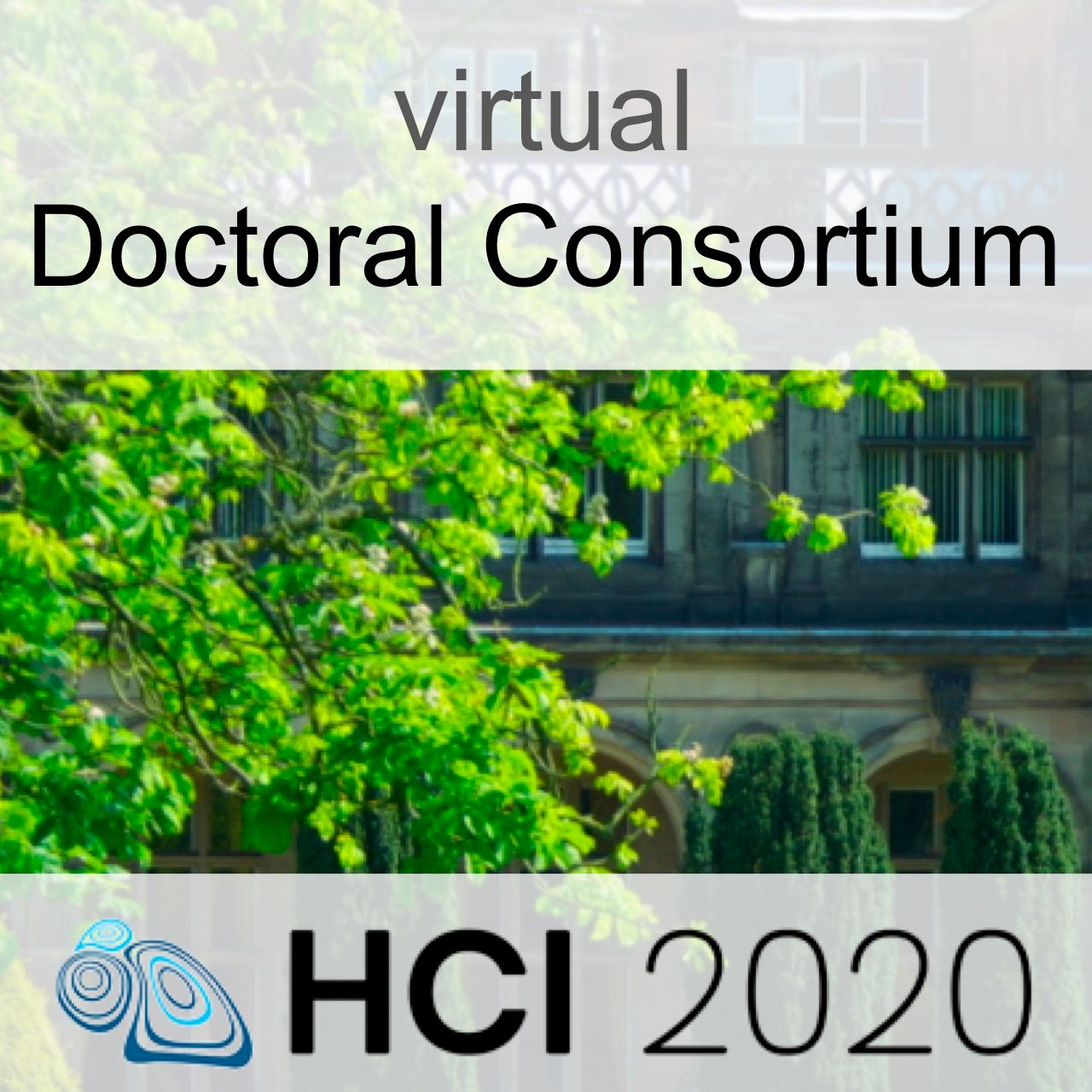Questions contributed by DC participants ... do you have answers/comments? Please tweet any answers adding #BHCIDC2020 and the question code (e.g. JM2)

SH2: How should we design ethical / trustworthy systems? What factors should we consider?
From Sam Hepenstal

AJ2: How does one excel in this field?
From Aisha Jaddoh

CK2: In the quantified-self community, the goal is to give the user as much control as possible over their data. But is there a point when giving users data about themselves (or their babies or pets) becomes harmful rather than helpful?
From Chloe Kliman-Silver

JA4: Do you feel haptic design is likely to evolve in developing tools, principles, and guidelines for UX in the same way as visual design or sound design?
From Joanna Aldhous

RM2: You can design systems/interventions for patients, but how do you design for patients experienced and set in their treatment (reluctant to adopt)?
From Ramsay Meiklem

DW2: What is the best way to get known for your work and get people excited about your research?
From Deborah Whittle

JA3: What do you feel are the main challenges to improving the user experience of interaction in VR?
From Joanna Aldhous

IE1: How do I restate academic findings in an industry format? Even coming from an industry background, it is difficult to hold both academic and industry models and communication styles in my head at the same time.
From Isabel Evans

DW1: What is the best way to get published and which journals do you think as the best to be published by?
From Deborah Whittle

JFM3: Is there any other similar or related research in our field that has explored the design of technology for stigma?
From Juan F. Maestre

DB2: Hornbaek and Oulasvirta argue that HCI lacks an account of how intentions are formed or affected by interaction. Do you agree, and if so, what do you think is the most promising route for addressing this?
From Daniel. Bennett

CK1: When working in a niche sub-field (like Animal–Computer Interaction), how do you make sure that your work still can be relevant or useful to the larger field?
From Chloe Kliman-Silver

ST1: As mentioned above, I particularly like the idea of non-interview and/or survey based research methods as a means of pushing research forwards. What are the best “alternative” research methods you’ve used, and why? Which would you advise against? Which research methods do you think will work better (or worse) as a result of social distancing?
From Sarah Turner

YA1: What is the best way to get in touch with companies that make costume design equipment for hardware?
From Yosuef Alotaibi

JFM2: Are there any other tools that I should be aware of in order to conduct HCI research remotely, and in particular for co-design workshops?
From Juan F. Maestre

JA1: As one of our main and fundamental senses why do you think that touch is not given the same consideration as sight or hearing in HCI?
From Joanna Aldhous

CG2: How can HCI research help the Covid-19 pandemic and can it help prevent future pandemics?
From Craig Goodwin

MS1: Do you have any advice regarding interdisciplinary imposter syndrome, particularly relating to HCI and critics who say it isn’t computer science?
From Madeleine Steeds

SH1: In critical situations the consequences of a poor decision, or a mistake, can be serious. When we hand reasoning power to a machine the machine becomes in some way accountable for the decisions. In a situation such as a criminal investigation, the human investigator must be held accountable (i.e. in court) for gathering evidence. We have proposed that transparency, which provides an ability to interpret the system behaviour including the goals and constraints, is an important step to ensure that the human user remains accountable. Is this fair? What other factors should we consider?
From Sam Hepenstal

IE4: If we are representing user archetypes in a narrow field, how much can we generalise? Or is it better to think of group characteristics that feed into a tool designer's specific persona design?
From Isabel Evans

BP3: Speech has potential to be fastest input modality and also can be useful approach in reducing the typing efforts but is being used lesser. Do you think it is because of accuracy/accent issues or it has not been taken seriously in HCI?
From Bharat Paudyal

OS2: How many workshops are recommended to conduct to validate participatory design methodology for particular context. If we develop novel methodology
From Olena Saienko

TR3: What are your experiences and opinions of a wearable device?
From Tendai Rukasha

KAK1: What advice would you give to someone who is completely new in the field of HCI research?
From Khalid Ahmad Khattak

CA3: What are best practices for conducting participatory qualitative research entirely online?
From Carlos Alvarez de la Vega

CG3: With Google advising against new Huawei smartphone users from sideloading Google applications, would we expect to see an increase in core GAPPS sideloading, or will most consumers abide by the advice?
From Craig Goodwin

JM2: How can software and usability be evaluated, especially using methods which can be completed remotely with exceptionally busy users?
From James Mitchell

BP1: How do we redesign user evaluation given the challenging around social distancing?
From Bharat Paudyal

JA2: What evaluation methods are suitable for evaluating haptic user experience?
From Joanna Aldhous

FQ1: How are human computer interaction techniques being adapted to design virtual reality applications?
From Fiona Quigley

IE2: The links, similarities and differences between UX (industry facing) and HCI (academic facing) are an example possibly of a miscommunication. Are they the same? How do they differ? And does this block moving academic findings into use in an industry setting?
From Isabel Evans

CA1: How can HCI better incorporate and inform other disciplines?
From Carlos Alvarez de la Vega

ST3: More specific to my research, I would like to ask what experience the researchers have, and recommendations that they may be able to give, about performing research with children, and families. Which methods work well, or less well? Have there been specific ethical concerns that you have faced, and how have you dealt appropriately with them?
From Sarah Turner

OS1: How to define if new methodological approach to design research is innovative enough? There are so many existing methods in HCI field, however when we adapt some methods to specific context it is hard to state, is it a new approach or modified existed method. For instance when we create new tool kit based on the elements of existed methods.
From Olena Saienko

CK3: How do you grapple with the new wave of AI - ”Human Centered AI?” While there are certainly many positives, is there a way to use it that ensures that the applicable populations (especially vulnerable ones) aren’t giving up their privacy? If not, when is a reduction of privacy worth it (i.e. giving up privacy for a coronavirus tracker)?
From Chloe Kliman-Silver

MT1: What are the implications of visualisation techniques to improve the learner performance associated with e-learning?
From Mithila Thiruppugal

YA1: Giving the current situation with the COVID-19 pandemic, would the face-to-face experiment structure change?
From Yosuef Alotaibi

ST2: Coming from a policy background, in particular, I am keen to make sure I get any salient findings beyond the academic sector, if they are worthwhile. How do you work on disseminating what you consider to be really important findings to non-academic stakeholders (e.g. manufacturers, policy-makers)? Did any specific groups take on board your findings better than others?
From Sarah Turner

KAK2: What mistakes should I avoid during my PhD (in Wearable Health Technology) ?
From Khalid Ahmad Khattak

DB1: What is the best way to frame a theoretical contribution to HCI? In recent years there seem to be less theory papers at CHI, but some basic concepts in HCI - affordances, agency, autonomy - still seem problematically ambiguous.
From Daniel. Bennett

SH3: HCI research requires an understanding of both the human and the technology. How do you consider both these aspects when conducting research?
From Sam Hepenstal

TR1: How to get postdoc positions or jobs in HCI?
From Tendai Rukasha

TR2: What are the most suitable methodologies for evaluating wearable device interfaces?
From Tendai Rukasha

IE3: Should personas always be project specific - tailored to a specific group of end users - or can they be generic? If generic personas are offered, could this mislead the tools designers who are not experienced in UX?
From Isabel Evans

JM1: How can working with experts following HCI methods (e.g. Clinicians) be evidenced, repeatable, and written in a thesis? (e.g. single person study)
From James Mitchell

MS2: When conducting online experiments, a certain degree of control over extraneous variables is forfeited. How do you decide what is an acceptable level of control to give up and do you have any advice in mitigating this?
From Madeleine Steeds

TB2: What do you consider the value to be of a co-design approach in the future of HCI in a healthcare context which involves participants who may also be patients?
From Tor Alexander Bruce

AJ1: How do some projects collaborate with medical institutions and companies regardless of their field? I would like to reach out to many organisations related to my project that could provide feedback and help me to determine requirements. Academics should always collaborate with industry to achieve the best results.
From Aisha Jaddoh

CG1: The Covid-19 pandemic continues to make in-person research more difficult, should future research methods be designed around this just in case?
From Craig Goodwin

RM1: How would you effectively test and evaluate a hybrid mobile application? Or what considerations would you make when evaluating mobile applications? (HCI)
From Ramsay Meiklem

BP2: Even though some researchers broadly focus on interaction with small devices such as smartphone, tablet but they are still categorised as HCI, is it not the time to distinguish HCI based on screen size or operating systems?
From Bharat Paudyal

TB1: Immersive Interactive Virtual Environments, also known as immersive rooms, spaces or cave-systems, show potential already as future interactive environments in healthcare. What do you think the compelling use cases might be for immersive rooms and what might be the barriers?
From Tor Alexander Bruce

FQ2: What is best practice in using wizard-of-oz techniques to design virtual reality applications?
From Fiona Quigley

MT1: How can LADs (Learning Analytics Dashboards) be designed in order to improve Students’ attention?
From Mithila Thiruppugal

CA2: What are best practices for HCI research to generate real-world impact?
From Carlos Alvarez de la Vega

JFM1: What are other ways in which one could gain access to stigmatized, marginalized, or vulnerable populations in order to conduct HCI research remotely (i.e., co-design workshops)?
From Juan F. Maestre
